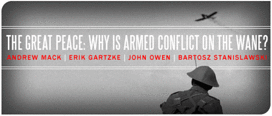To Bartosz Stanislawski: Couldn’t the presence of “non-state threats” imply an important corollary for Andrew Mack’s thesis? If states really are not fighting much any more, extremists must resort to the admittedly more marginal acts of insurgency and terrorism. Even Mao Zedong said that these tactics seldom work in and of themselves, except that poor policies by states open avenues to the capture of state power, which then can be used for revolutionary ends. In other words, instead of seeking non-state conflict as more than it is, perhaps the rise of this type of conflict is a sign that state warfare is one the wane, long term.
As an aside, and as a matter of fact, people in 1939 could have only been optimistic if they ignored the statistics and history. There was a brief respite of warfare in the 1920s and early 1930s, but the longer-term trend was still increasing in the first decades of the 20th century.
Also, it is simply not good theory or policy to treat nonstate actors as irrational, especially when treating other actors as rational. Extremism may be abhorrent, but to doubt that it has a logic is to commit the classic error of underestimating one’s enemy. Again, as a point of fact, there is a considerable and growing theoretical literature that does exactly this, treating extremists as if they have reasoning abilities too. Why conflate extremism with irrationality and moderation with rationality, especially when this disarms to some degree both sets of concepts?
To John Owen: Could your argument not support a more optimistic conclusion than even that of Andrew Mack? In Dr. Mack’s world, the decline of U.S. hegemony does pose important potential risks, particularly if, as you note, the United States has been carrying the burden of sponsorship of global markets and the like. If instead we think of the “nuclear peace,” then paradoxically there is reason for more optimism. No one seriously thinks the United States will be unable to maintain a large nuclear arsenal far into the future, even if it does decline in relative terms on other dimensions of power. The Soviet Union completely collapsed in 1992. If we are to believe the nuclear peace, then we must also accept that a humbled Russia has succeeded in maintaining global stability by its nuclear balance with the United States, despite all sorts of problems both in its nuclear and conventional forces, and in its larger economy. Presumably, the United States will also be able to maintain a stalemate with any rising powers, because of the presence of its nuclear arsenal. Strangely, this implies that an Owenesque future could be more peaceful than Mackian one. (!)

